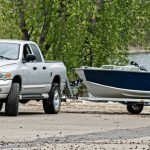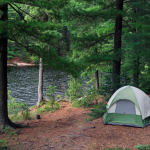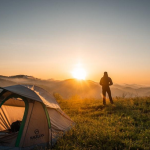Ever been caught in the middle of a camping trip, shivering inside your tent because you did not pack the right camping essentials? It is not exactly the perfect jaunt, is it? You have a whole lot to consider when packing for outdoor escapades.
You see, heading out into the wilderness requires more than just sheer will and wanderlust. The stakes are high – think chilly mountain ranges at night or sudden downpours that can soak through inadequate tents.
The sleeping bag you choose could make all the difference between sweet dreams under starry skies or freezing nights tossing around on cold ground. That lumbar pack may seem small but trust me, its role in carrying key gear like medical kits is huge!
Whether you are a seasoned adventurer or just starting out, this camping essentials guide is jam-packed with insights. It will help you choose the right sleeping gear for camping and give advice on camping essentials to pack.
Camping essentials for beginners
Setting out on your initial camping journey can be an exciting undertaking. To ensure your camping trip is a success, you must have the correct camping essentials. Our beginner-friendly camping essentials and adventurer essentials checklist covers all bases, from choosing a tent to picking out the perfect sleeping bag.
Choosing your first tent
Picking the right shelter is crucial for a comfortable camping experience. There are a wide range of tents available at Valley and Peak, catering to different needs based on size, weather resistance and ease of setup.
The ideal tent will depend on factors like trip duration and expected weather conditions. Size matters too – if you are trekking mountain ranges with heavy equipment, opting for something lightweight but sturdy would work best.
Tent accessories
When setting up your campsite, do not overlook tent pegs and accessories like repair kits. They might seem trivial until you are in a fix – be it securing your shelter during strong winds or dealing with unexpected tears. Having duct tape at hand is always wise – its versatility goes beyond just fixing rips and punctures.
Essential sleeping gear
A quality sleeping bag is more than just a bedtime comfort; it is an essential survival tool in varying weather conditions outdoors. Lightness paired with warmth should guide your choice here. Our ultimate sleeping bag guide offers detailed advice, helping you find one that suits both budget and purpose perfectly.
Remember, quality trumps cost when it comes to investing in good sleep during outdoor adventures.
In addition to bags, consider other elements such as quilts depending upon climate and personal preference. A well rested camper is a happy camper.
Recap
Heading out on your first camping adventure? You will need the essentials to make it a success. Choose a tent based on size, weather resistance and setup ease. Do not skimp on quality when picking out your sleeping bag – good sleep is key for outdoor fun. Also consider extra comfort items like quilts. And let us not overlook those additional necessities such as cooking equipment, torches or even some handy tools. They can truly enhance your camping essentials kit and therefore your camping experience.
Sleeping comfortably in the outdoors
For a good night’s sleep outdoors, selecting appropriate sleeping gear such as bags, quilts and mats is essential. With brands like Big Agnes offering a huge range of options, you can pick lightweight and compact gear that won’t weigh down your backpack.
The importance of warmth cannot be overstated when it comes to selecting an outdoor sleeping bag or quilt. Just as you would not use a tin opener for puncture repair, choosing the right tool (or in this case, camping equipment) makes all the difference between shivering through the night and waking up refreshed.
If we consider tents as our temporary homes while camping, then sleeping bags are our beds. But not just any bed – think of them more akin to those cosy duvets during cold winter nights. The science behind their design has evolved significantly over time. Modern materials have allowed for impressive engineering cutting-edge designs that prioritise comfort without compromising on weight or packability.
Finding your perfect sleeping bag
Just like Goldilocks’ porridge needs, some people prefer warmer sleeping conditions while others may need less insulation. We understand how critical these choices are because we’ve spent countless nights under starry skies amid towering mountain ranges.
When planning a trip, the duration should be taken into consideration as it can affect which type of bedding is necessary. A short weekend getaway might only require light bedding, but an extended skiing expedition would demand serious thermal protection.
Sleeping mats vs Closed Cell Foam (CCF)
When delving into the world of extreme outdoor expeditions, your quest for a restful night’s sleep becomes not only a matter of personal comfort but also a crucial element of survival.
When I began my backpacking ventures, the concept of modern sleeping mats was still in its infancy. Back then, when our Scout troop embarked on hiking trips, we often braved the elements by sleeping directly on cold groundsheets. The situation did not improve much in the summer. However, youth has a way of making you resilient to discomfort, and we made do. At times, when we camped in Patrol tents at Scout camp, some of us resorted to using old newspapers as insulation – a piece of wisdom passed down as a way to shield ourselves from the icy ground.
A paradigm shift occurred with the introduction of Closed Cell Foam (CCF) mats. These mats quickly gained popularity, and anyone familiar with camping during that time would recall the iconic bright yellow mat from Karrimor, known as the Karrimat. This relic of the past, still cherished by many, stands as a testament to the early days of camping. While the Karrimat offered comfort and warmth, it had its drawbacks, including bulkiness that required strategic packing in already-stuffed backpacks. However, it marked the beginning of a new era of comfortable and warm nights in the wilderness.
CCF mats, like the Karrimat of old, are a practical and relatively inexpensive choice for outdoor enthusiasts. They come in two primary styles: roll or concertina. What sets them apart is their durability, being virtually puncture-proof and resistant to moisture absorption. While these mats may lack the plushness of contemporary options, they remain a favourite among ultralight long-distance hikers who value their resilience and minimal weight.
The R-value, an essential metric for assessing a mat’s insulating capability, is of paramount importance in the context of extreme cold. Understanding R-values is critical when selecting a sleeping mat, as it signifies the mat’s capacity to resist heat loss. The higher the R-value, the better the mat can shield against cold temperatures.
Notably, individual preferences and sleep patterns come into play, as some individuals naturally sleep warmer or colder than others. Factors such as the time of year, anticipated conditions, and type of shelter used also influence mat selection. Inadequate mats often lead to users feeling cold, even when their sleeping bags or quilts should provide sufficient warmth. This consideration is particularly vital when using sleeping quilts, as they lack the back insulation of a traditional sleeping bag.
In 2020, a new industry standard, ASTM F3340-18, introduced a more rigorous and standardised methodology for measuring the R-value of sleeping mats, enhancing the accuracy of comparisons between different products. This allows consumers to make informed choices when selecting sleeping mats.
During winter expeditions, especially in December and early January, extended periods are spent inside the tent, with early entry as soon as 3:30 in the afternoon, and a delay in emerging until as late as 8:00 the following morning. In these circumstances, a comfortable and warm sleeping mat becomes indispensable, ideally one as wide as feasible. Skimping on mat quality during winter outings, assuming that a three-season mat will suffice to save weight, is not advisable. In these conditions, a significant amount of cold seeps up from the ground, especially when camping on snow. When considering a mat for winter, aim for an R-value of at least 4. And for cold sleepers, an R-value of 4.5 is recommended. Additionally, using CCF foam near your sleeping area, if space and weight allow, can prevent contact with a frigid groundsheet when exiting your sleeping bag. These small considerations can make a substantial difference in the harshness of winter conditions.
If you are unsure about which product to choose, contact us and we can give expert advice on how to fine-tune your gear choices for specific expeditions.
Recap
The evolution of sleeping mats, from the days of sleeping directly on cold ground to the introduction of Closed Cell Foam (CCF) mats like the iconic Karrimat, has revolutionised outdoor comfort. Understanding R-values is vital for selecting the right mat, with a new industry standard introduced in 2020. Winter expeditions demand wide, high R-value mats for extended tent time.
Choosing the right gear for your camping trip
Packing camping essentials for a trip can be quite an undertaking, particularly if you are unfamiliar with the outdoors. The key is choosing gear that’s right for your specific needs.
Selecting suitable clothing and footwear
Outdoor clothing and footwear selection depends heavily on weather conditions and terrain. Let us consider clothing and footwear. A waterproof jacket is essential in rainy or damp conditions. Lightweight, breathable fabrics are best during warmer months but remember to pack layers as temperatures can drop significantly at night.
The type of shoes or boots you choose should also reflect the environment where you will be trekking. Rugged mountain ranges require sturdy hiking boots, while lumbar packs with padded hip belts help distribute weight evenly when carrying heavy loads – ideal if you are backpacking across challenging terrains.
Packing your backpack efficiently
A well-packed backpack can make all the difference during your adventure, particularly considering trip duration and luggage load. Be mindful about how much stuff sacks will carry – it is tempting to bring more than needed. Consider using compact backpacking packs and lumbar packs, designed specifically for outdoor adventures.
You want heavier items near your back so balance is not thrown off while lighter things should sit closer to the top or outside pockets making them easily accessible without having to rummage through everything else first.
To maximise space efficiency inside these bags, use stuff sacks – small pouches which allow clothes/items to compress down into manageable sizes taking up less room overall, allowing extra packing capacity elsewhere within the pack itself.
Now, let us not forget about your shelter. Different types of tents are obtainable, each created to meet diverse camping requirements. From 1-person tents suitable for solo travellers or couples, to larger ones accommodating families or groups – the options are vast. Remember that weather conditions can significantly impact your choice of tent.
For instance, if you are expecting rain during your trip duration, a waterproof option is crucial while those planning on winter camping might need an insulated version instead. Valley and Peak offers unique or customised solutions tailored specifically towards specific outdoor requirements.
Recap
When planning a camping trip, gear selection is vital. Tailor your clothing and footwear to weather conditions and terrain, pack your backpack efficiently using stuff sacks for space-saving benefits and select a tent that suits both the size of your group and the expected weather.
Staying safe and prepared in the wilderness
Being prepared for your camping trip is not just about having a comfy sleeping bag or a sturdy tent. Ensure you have the necessary safety gear such as first aid kits and hydration packs for your own protection while camping.
The importance of hydration packs
To stay hydrated during your outdoor adventures, make sure to carry hydration packs. Carrying a hydration pack is essential to keep your backpack light yet still allow you to take enough water for long treks where natural sources may be limited. They can be lifesavers when trekking mountain ranges where fresh water sources might be scarce.
Apart from quenching thirst, staying hydrated helps regulate body temperature and ensures proper functioning of muscles and joints. So when you are hiking or exploring new terrain, hydration packs help keep you at peak performance.
Sun protection: more than just sun cream
Sun protection is another key aspect that beginners often overlook while preparing their camping checklist. Yes, sun cream protects against harmful UV rays but remember to bring along other protective items like hats and sunglasses too.
In addition to these basics, clothing with built-in SPF protection can provide an extra layer of defense against the harsh midday sun when you are out in open mountain ranges.
Your first line of defence: the first-aid kit
No one likes accidents but sometimes they are unavoidable on a wilderness adventure. This makes carrying a well-stocked first aid kit non-negotiable.
- medical tapes
- puncture repair kits
- duct tape (for temporary fixes)
These are just a few examples of what your first-aid kit should contain. They might seem like small things but in an emergency these can make all the difference.
Fending off bugs with insect repellent
Camping is fun until you’re swarmed by mosquitoes or bothered by bugs. This is where insect repellents come in handy, helping to keep pesky bugs away and shielding against illnesses that they may bring.
Cooking delicious meals outdoors
Experiencing the joy of cooking delicious meals outdoors, whether you are a seasoned camper or on your first trip, requires having suitable equipment and storing food safely. Still, it is vital to have the correct cooking apparatus and be aware of how to store food securely.
Choosing your outdoor cooking gear
Selecting outdoor cookware is more than just picking up any old pot or pan from home. It is about understanding what materials are best suited for outdoor conditions and align with your needs. Two popular choices are titanium and aluminium due to their lightweight properties.
Titanium cookware, while slightly pricier, is incredibly durable and heat-resistant making it an excellent investment for frequent campers. On the other hand, aluminium pots and pans conduct heat evenly allowing for well-cooked meals but require careful handling as they may dent easily.
If durability tops your list then consider stainless steel – robust yet heavier in weight compared to its counterparts. Remember that different situations might call for different solutions. A week-long hiking expedition would favour lighter options whereas car camping trips could accommodate sturdier sets like stainless steel.
The powerhouse: camping stoves
A reliable stove is at the heart of every successful meal cooked under open skies. From boiling water quickly for coffee (or those dehydrated meals) to simmering a delicious pasta sauce, investing in something dependable like the MSR PocketRocket Deluxe Stove ensures all culinary bases are covered during your adventures.
Remember to choose a stove that aligns with your camping style and conditions. For example, if you are planning on camping in high altitudes or colder weather conditions, consider a liquid fuel stove as it performs well under these circumstances.
Safety first: food storage
The key to good food storage while camping is keeping everything clean and dry in the perfect camping coolers. Opt for sealable containers or stuff sacks, which are lightweight and help organise meals better than plastic bags ever could.
Avoid attracting unwanted wildlife by storing all food items securely at night – either in bear canisters where necessary or hung from trees using the ‘bear bag’ method. A bit of precaution can save potential hassle.
Recap
Whipping up tasty meals on a camping trip is part of the fun, but you need to have the right gear. Choose cookware that suits your needs – lightweight titanium or aluminium for frequent campers, robust stainless steel if weight isn’t an issue. A reliable stove like the MSR PocketRocket Deluxe can cover all your cooking bases from coffee to pasta sauce. Do not forget about storage – it is crucial for keeping food fresh and equipment organized while enjoying outdoor adventures.
Exploring the great outdoors with the right equipment
If you are planning to venture into nature’s lap, you will need more than just a good pair of hiking boots. Equipping yourself with the right gear is crucial for an enjoyable and safe outdoor experience.
Enhancing your camping experience with head torches
A head torch can be a game-changer on your camping trip. It provides hands-free illumination when night falls – think navigating trails in low light or setting up camp after dusk. The best part? Many modern head torches are lightweight and rechargeable.
Your backpack should also include essential items like lumbar packs for carrying small but necessary items at easy reach, trekking equipment if mountain ranges are part of your itinerary, hydration packs to ensure water supply during long hikes and medical kits for emergencies.
Selecting appropriate clothing and footwear
The weather conditions can change quickly outdoors – from scorching heat in daytime to chilly winds at nightfall. Hence it is important that your clothing offers protection against different elements while being comfortable enough for all-day wear. Waterproof jackets from trusted UK outdoor clothing brands offer both functionality and style.
You do not want blisters ruining your hike; thus investing in quality footwear designed specifically for rugged terrains is non-negotiable. Remember: comfort equals longer distances covered without fatigue.
Packing efficiently: backpacks and lumbar packs
Packing efficiently ensures nothing vital gets left behind while avoiding overloading yourself unnecessarily – trust me I have learned this through years of trial-and-error. Whether you opt for a traditional backpack or the more compact lumbar pack, consider factors like trip duration and luggage load. If your camping trip is likely to last several days, larger backpacks from Valley and Peak are ideal.
The way you pack matters too. Place heavier items towards the bottom of your bag while keeping camping essentials handy at the top or in the side pockets.
Recap
Heading out for a camping trip? You will need more than just sturdy boots. Equip yourself with essential gear like head torches, lumbar packs and hydration kits to enhance your outdoor experience. Dress smartly in weather-resistant clothing and invest in quality footwear for comfort during hikes. Remember: packing efficiently is key. If you are planning on being away for a while, it is best to opt for larger backpacks that can hold all of your essentials.
Additional optional extras for a comfortable camping experience
A camping trip can be made even more enjoyable with some additional extras. Selecting additional items can provide an extra level of comfort for your excursion into the outdoors.
Choosing comfortable camp furniture
Picking the right camp furniture is key to enjoying your downtime in nature. When it comes to selecting chairs or tables, consider their weight and packability first.
Camp furniture should also withstand weather conditions. It is no fun sitting on a soggy chair. Consider waterproof materials like those used in waterproof trousers.
In terms of brand options available at Valley and Peak, there are plenty that cater to different needs, including ultralight stools from Big Agnes which provide convenience without sacrificing comfort.
The added benefit of waterproof clothing
Besides being essential during rainy weather conditions, waterproof clothing such as jackets and trousers serve other purposes too. They make excellent windbreaks when you are sitting around the campfire on breezy nights or they could double up as quick-dry towels after a swim in a lake.
Tent footprints: extra protection for your tent floor
An often overlooked item by first-time campers is the tent footprint – essentially an under-sheet that protects your tent floor from rough terrain damage and helps keep things dry inside if it rains heavily. So remember this when packing gear for trekking mountain ranges where rocky terrains are common.
Essential tips for a successful camping trip
If you are organizing your maiden camping excursion, it can be a bit intimidating to work out what to bring camping. However, worry not. I am here with some essential tips and recommendations from personal experience, and our trusted outdoor brands like Big Agnes, Sierra Designs, Sea to Summit, Enlightened Equipment and Outdoor Research.
Choosing the right gear
Your camping gear should align with the weather conditions you will face on your journey. The camping essentials include a tent footprint for added protection under your tent or shelter; sleeping bags that offer comfort in varying temperatures; lumbar packs for carrying necessities during treks; head torches providing light when needed most – all available at Valley and Peak.
Remember there is no one-size-fits-all approach here because each person’s needs will vary depending on factors such as trip duration and expected terrain.
Packing your backpack efficiently
An efficiently packed backpack can make a huge difference in comfort levels while trekking mountain ranges or even just setting up camp. Start by making sure heavy items are placed towards the middle of your pack – this helps maintain balance.
The outer pockets are perfect spots for frequently used items like water bottles or maps. Consider using stuff sacks within your bag too – they help organise smaller items while saving space.
Lumbar packs from Valley and Peak could be an excellent choice if you are after something lighter.
Cooking outdoors
A successful camping adventure is not complete without a satisfying meal at the end of each day. Having good quality outdoor cooking equipment is crucial for this reason.
The MSR PocketRocket Deluxe Stove is an excellent option that is both compact and powerful, ideal for backpacking trips. Do not forget to bring along your kitchen essentials like a tin opener, bottle opener, cutlery and bin bags – all easily forgotten but important.
Staying safe in the wilderness
Your safety should be paramount when camping outdoors. A well-equipped first aid kit can help you deal with minor injuries or health issues while hydration packs are essential to keep dehydration at bay.
Recap
Remember, safety is key. Ensure your first aid kit is well-stocked. This will help you to handle any minor injuries or emergencies that may occur during your trip. Pack smart, stay safe and enjoy the great outdoors.
FAQs in relation to camping essentials
What must I bring during camping?
Pack camping essentials like a tent, sleeping bag, cooking gear, first-aid kit and food. Do not forget personal items like clothing that is suitable for the weather.
What do you need for 2 nights camping?
Apart from your tent and sleep gear, pack enough food and water for three days. Bring layers of clothes to stay warm at night too.
What food to bring on a long camping trip?
Select non-perishable foods such as canned goods or dry mixes. Add high-energy snacks like trail mix. Remember fresh fruits that last well outdoors.
What should I pack for family camping?
In addition to basic camp supplies, take games or activities for kids. Pack more snacks than usual – they will burn through them fast.
When it comes to your outdoor adventures, packing the right camping essentials can make all the difference.
The perfect sleeping bag? It is not just about comfort; it could mean the difference between a restful night and shivering ‘til dawn. A lumbar pack may seem small but, remember, its role in carrying vital gear is huge.
Tents are more than mere shelters – choose wisely based on weather conditions and trip duration. And let us not forget cooking equipment – because who said you cannot enjoy delicious meals while camping?
Pack smart, prepare well and remember: every item in your backpack counts when trekking mountain ranges or setting up camp under starry skies.







